Evergreen Shrubs For Full Sun (The Best Bushes For Year Round Interest)
Whether you are looking for foundation plants for the front of your house, need to plant a hedge for privacy or just want to improve the look of your garden beds, these evergreen shrubs for full sun will make a great addition to your yard.
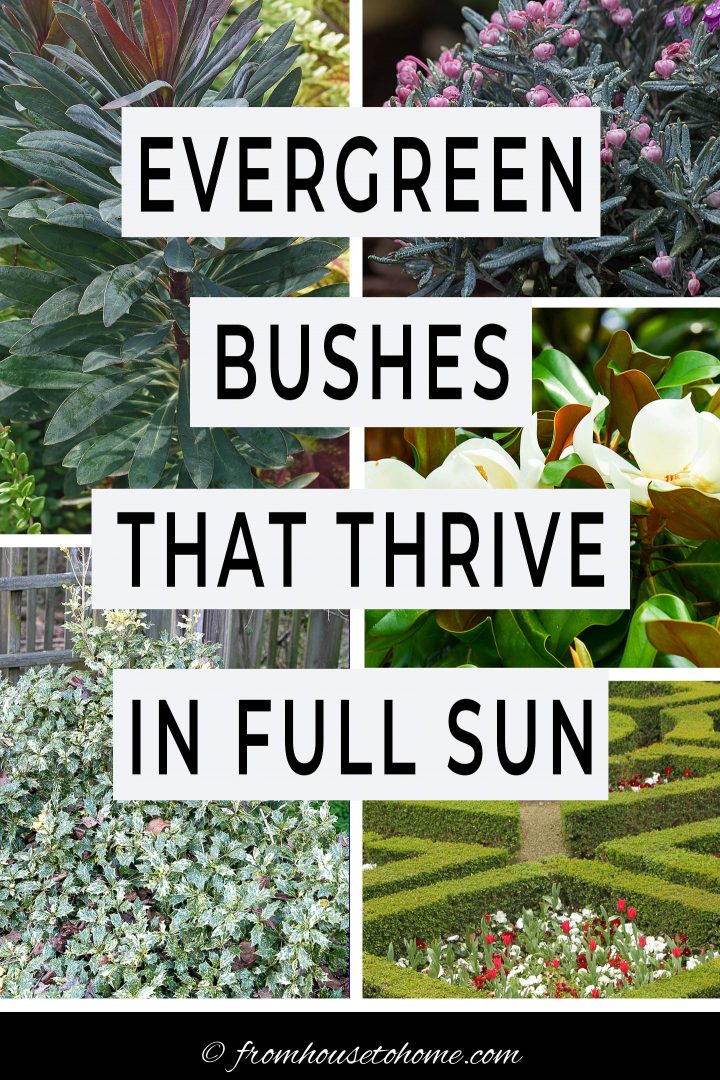
Planting evergreens in your garden is one of the easiest ways to add year round interest to your yard.
Since the plants are always green, they provide interest and structure even when the rest of the garden isn't looking its best.
If you need bushes that will thrive in a sunny location, then this list of evergreen shrubs for full sun will provide some inspiration.
For the shady spots in your garden, check out our evergreen shrubs for shade list.
1 | Blackbird Spurge (Euphorbia ‘Blackbird')
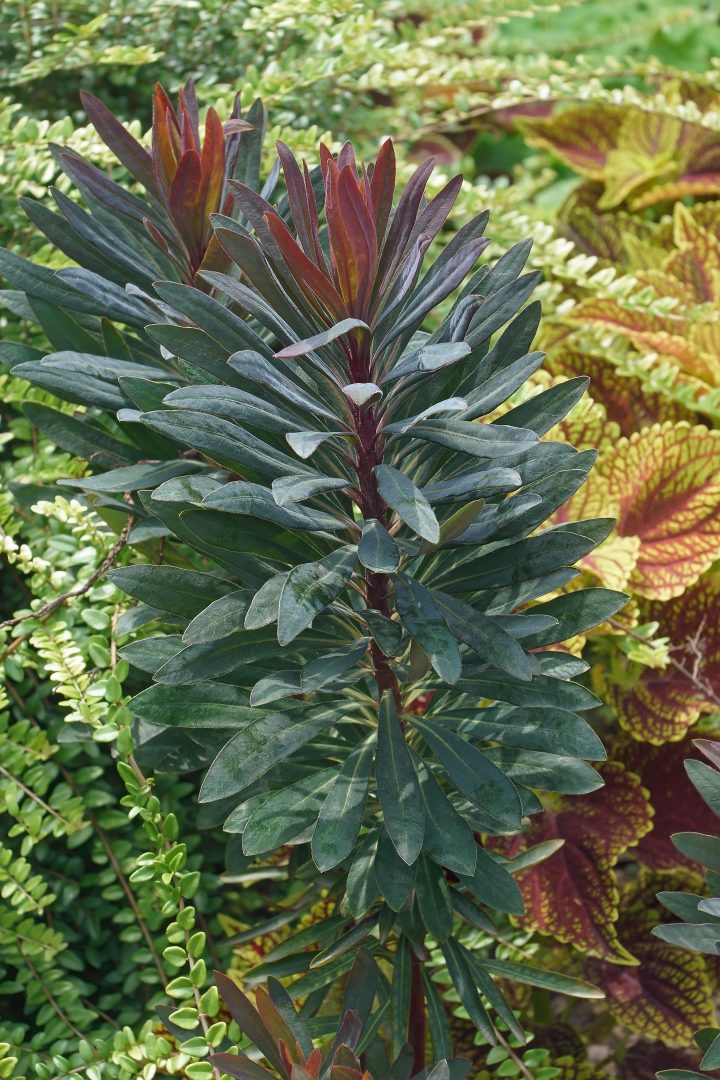
Zones: 6 to 9
Light: Sun to Part Shade
Bloom Time:
Height: 1′ to 2′
Spread: 1′ to 2′
Blackbird spurge (Euphorbia ‘Blackbird') is a bushy, dwarf evergreen shrub with colorful foliage that looks good all year round.
In the spring, it is topped by yellow-green flowers that put on a show until summer.
This plant is a favorite with gardeners because of its dark-colored leaves that turn almost black in the sun and provide color in the garden all year round.
In addition to being drought-tolerant and deer- and rabbit-resistant, Euphorbia ‘Blackbird' also makes a good container plant. A very versatile plant!
2 | Encore Azalea
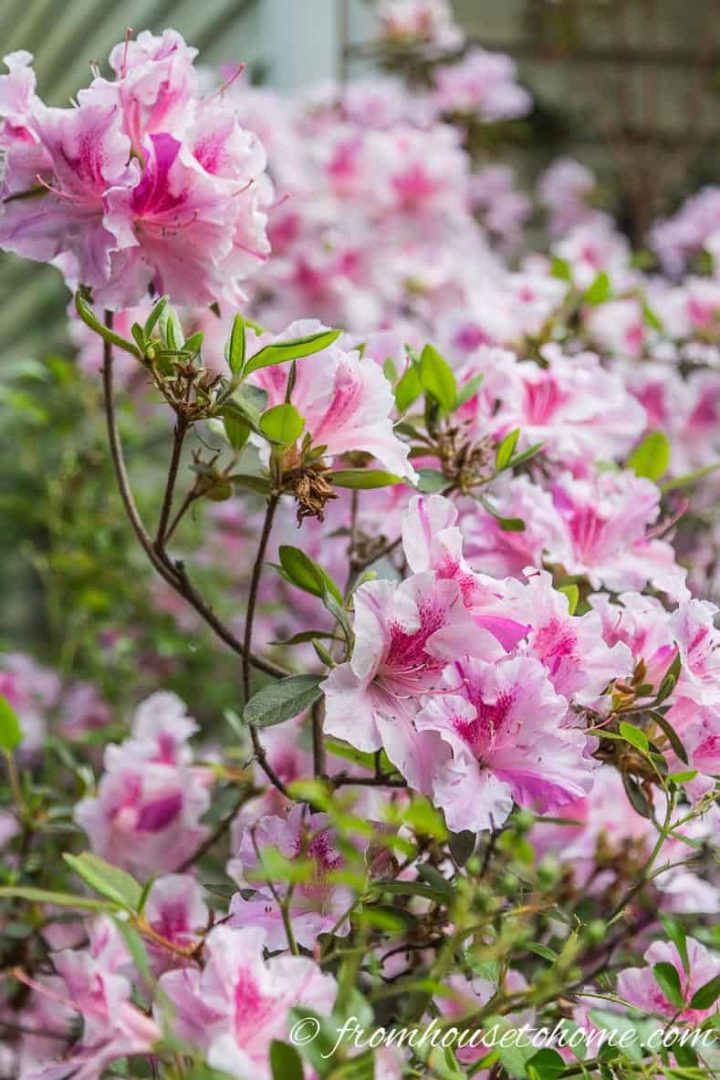
Zones: 5 to 10
Light: Sun to Part Sun
Bloom Time: Spring to Fall
Height: 3′ to 6′ tall
Spread: 3′ to 6′ wide
Encore Azaleas are a re-blooming variety of Azaleas that has a big showing of flowers in the spring and then continues to bloom sporadically for the rest of the growing season.
They are different than most evergreen Azaleas in that they bloom best in full sun, and will thrive all the way up to zone 10.
As with most Azaleas, they prefer acidic soil and moist but not waterlogged soil.
If you are growing them in zone 5, some winter protection may be required.
You can find out more about Encore Azaleas HERE.
3 | Blue Ice Bog Rosemary (Andromeda polifolia ‘Blue Ice')
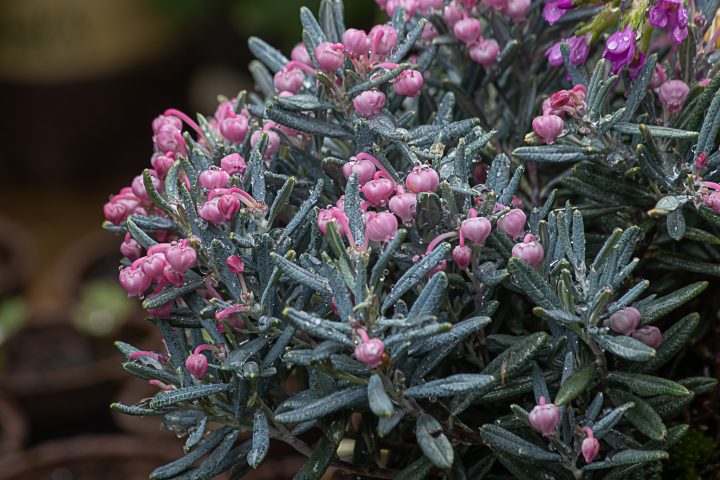
Zones: 2 to 7
Light: Sun to Part Shade
Bloom Time: Early spring
Height: 12″ to 24″
Spread: 24″ to 36″
As the name suggests, Blue Ice Bog Rosemary (Andromeda polifolia ‘Blue Ice') is a small evergreen native shrub with blue green leaves that thrives in wet conditions and doesn't mind the cold.
Although the name implies that it's part of the rosemary family, it's actually a cousin of heather and is not edible.
In fact, Bog Rosemary is poisonous so make sure you don't get it confused with the herb.
During the winter, it's needle-like leaves add texture to your garden. And the blue really stands out against the snow.
Then the unusual pink blooms arrive in early spring to add another pop of color.
It only has one requirement: That you keep it well watered.
Plant as a ground cover or border plant to add winter interest and structure to your garden.
4 | Chinese Fringe Flower (Loropetalum Chinense)

Zones: 7 to 10
Light: Sun to Part Shade
Bloom Time: Spring
Height: 3′ to 10′ (depending on the variety)
Spread: 3′ to 8′
Chinese Fringe Flower (Loropetalum chinense) is a fast-growing evergreen shrub that produces lots of flowers in the spring and then scattered blooms through the rest of the season.
There are two types of this shrub – one with white flowers and green leaves, and another with pink flowers and purple leaves that turn green as they mature.
Plant Chinese fringe flower in acidic soil and it will be easy to grow with few problems
Prune after the spring flowers have faded to control the size.
5 | Magnolia Grandiflora
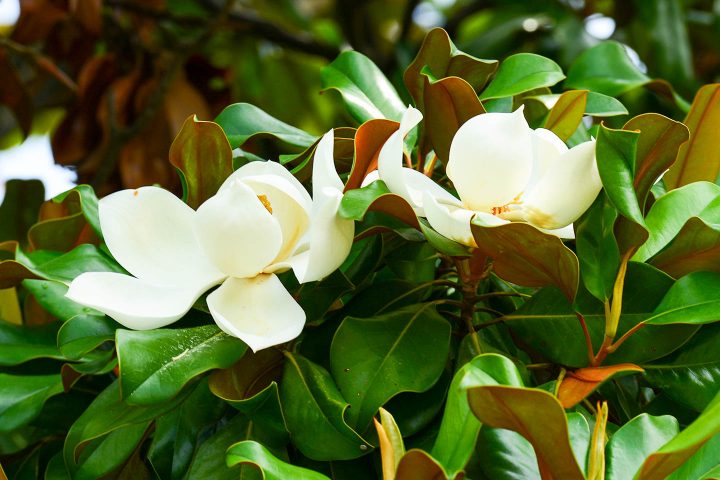
Zones: 7 to 9
Light: Full Sun to Part Shade
Bloom Time: Late Winter, Spring or Summer (depending on the variety)
Height: 20′ to 65′ tall
Spread: 20′ to 50′ wide
If you live in the South and are looking for a tall evergreen, it's hard not to think of Magnolia grandiflora.
It's the quintessential Southern plant with glossy dark green leaves and huge white fragrant flowers that blooms in the spring, and repeats sporadically throughout the summer.
Like many Magnolias, it thrives in acidic soil and prefers sunny to partially shaded locations.
There are quite few cultivars available in different shapes and sizes so find the one that fits your yard.
Click HERE to find out more about Magnolias.
6 | Boxwood (Buxus)
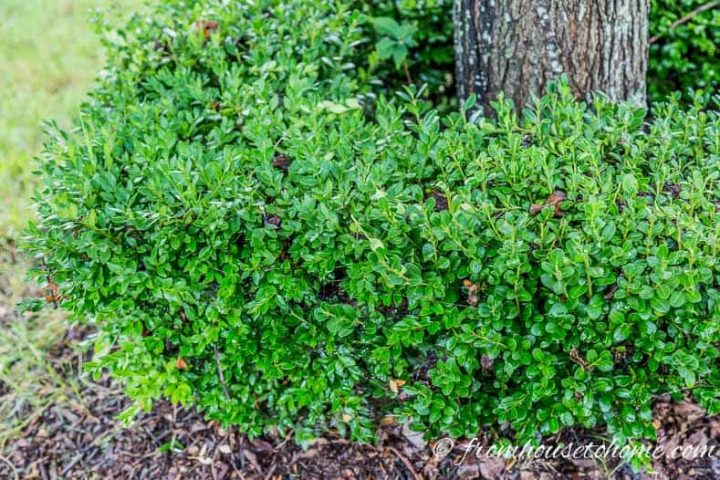
Zones: 4 to 10
Light: Sun to Shad
Bloom Time: Foliage only
Height: 1′ to 12′ (depending on the variety)
Spread: 2′ to 8′
Boxwood (Buxus) is a deer-resistant, evergreen shrub that grows well pretty much anywhere and in any kind of light.
We most often associate it with clipped hedges and balls in formal gardens.
However, it is such an easy plant to grow I think it deserves a place in any garden. And can be used as a foundation plant, in containers, as a hedge, or clipped into a shape.
Adequate water and 3 inches of mulch take care of its maintenance needs.
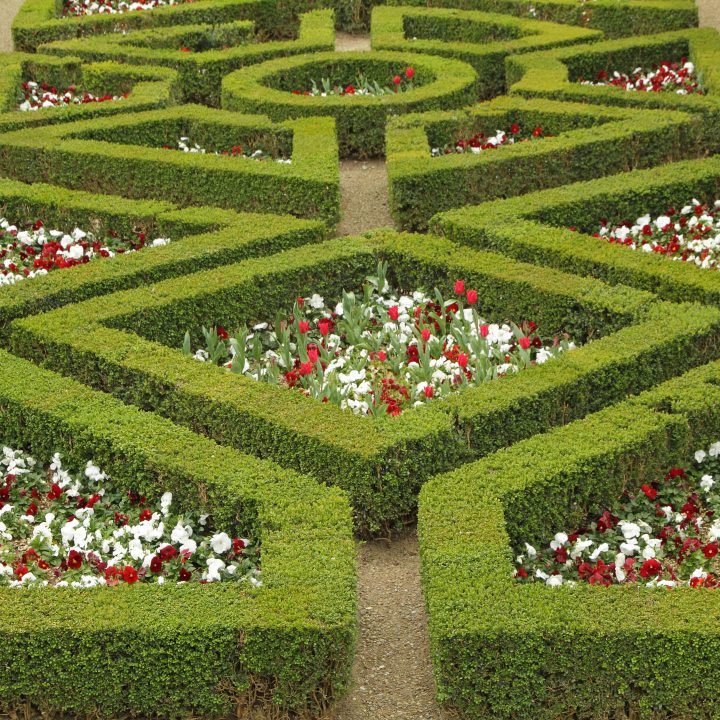
Aesthetically, Buxus looks much better pruned so that its small evergreen leaves become denser. It is a slow growing shrub so once the desired shape is established, it only needs an annual shearing.
Planting flowers in the middle of a boxwood shrub border can be one way to add some more color.
Click HERE to learn more about growing Boxwood.
7 | Wintercreeper (Euonymus fortunei)
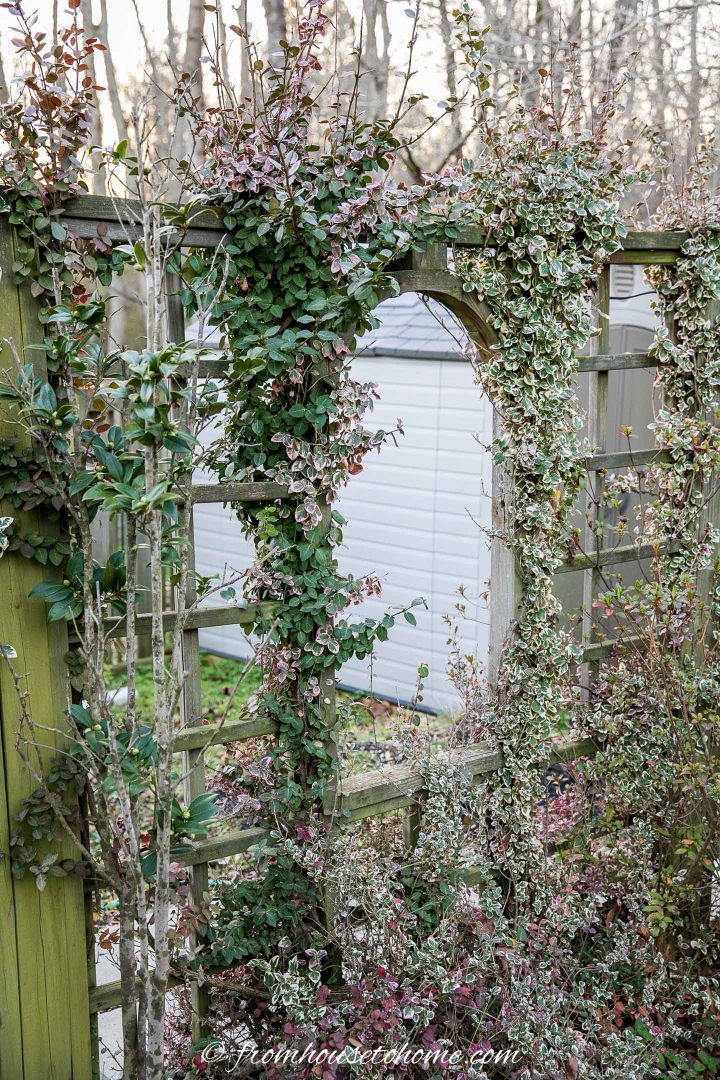
Zones: 4 to 9
Light: Sun to Shade
Bloom Time: Spring
Height: 2′ to 4′ as a shrub; up to 60′ as a vine
Spread: 4′ to 10′
Wintercreeper (Eonymus fortunei) is a broadleaf evergreen shrub for full sun (or shade) that can also be grown as a ground cover or a vine.
With it's variegated leaves that take on a pink tint in the winter, wintercreeper adds interest to your garden all year round.
It has insignificant greenish-white flowers in the spring but is usually grown for its foliage.
Euonymus fortunei is very easy to grow, tolerating drought and pretty much any kind of soil except bog conditions.
It requires pruning to maintain its size and shape since it can become invasive if left to its own devices.
8 | Blue Star Juniper (Juniperus squamata ‘Blue Star')

Zones: 4 to 8
Light: Full Sun
Bloom Time: Foliage only
Height: 1′ to 3′ tall
Spread: 1′ to 3′ wide
Blue Star Juniper is a dwarf evergreen shrub with blue needles that naturally forms a ball shape.
It grows best in full sun, but can do quite well in part shade as well.
And it is very tough!
I have it growing along a south-facing wall between the side of my house and the front walkway. It gets very little water (it's covered by the roof overhang), rarely needs to be pruned, and survives the heat of our South Carolina summers with no problems.
9 | Bird's Nest Spruce (Picea Abies ‘Nidiformis')
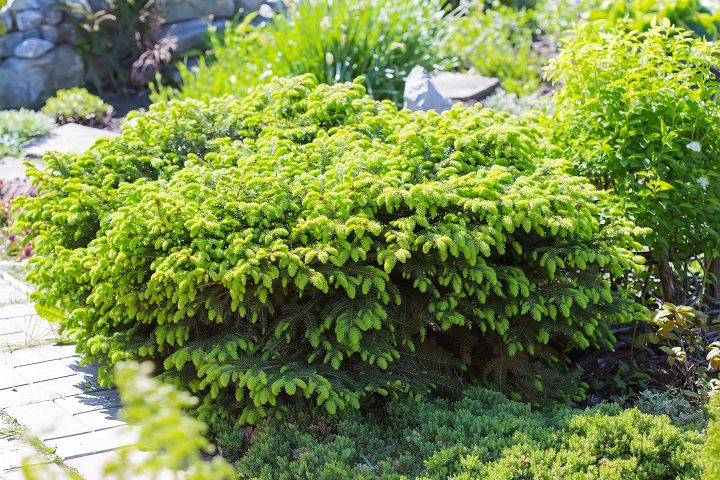
Zones: 3 to 7
Light: Sun
Bloom Time: Foliage Only
Height: 2′ to 8′
Spread: 3′ to 12′
Bird's Nest Spruce is a dwarf variety of the Norway spruce that gets its name from its shape.
It grows slowly to form a flattened sphere that is the perfect size for foundation plantings, rock gardens or to add some year-round structure to the front of a garden bed.
New needles come out as a bright green color that turns to gray-green as they age.
This shrub is deer resistant and very low maintenance. It only requires occasional pruning to maintain its size.
10 | Dwarf Mugo Pine (Pinus mugo var. pumilio)
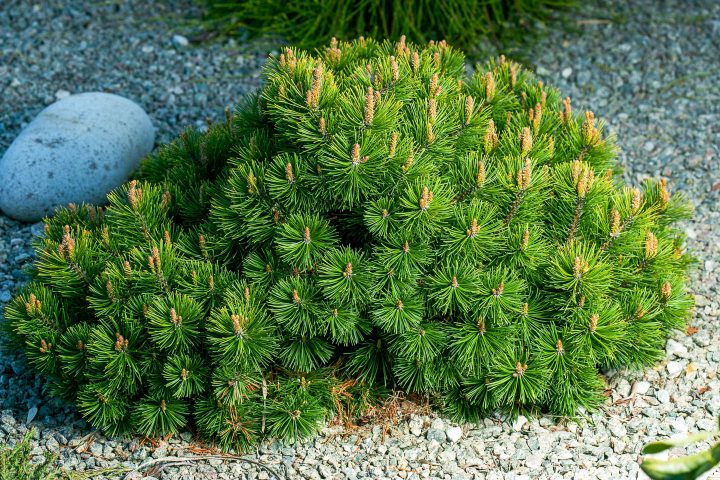
Zones: 2 to 8
Light: Full Sun
Bloom Time: Foliage Only
Height: 3′ to 5′ tall
Spread: 6′ to 10′ wide
Another small evergreen bush for full sun is the Dwarf Mugo Pine (Pinus mugo var. pumilio).
It's a slow-growing conifer with dense needles that looks great in rock gardens, at the front of the mixed border or as part of a Japanese garden.
Once established, it is drought-resistant, requires very little pruning and and is extremely tolerant of pollution. A very low maintenance plant!
11 | Arborvitae (Thuja)

Zones: 3 to 9
Light: Full Sun to Part Sun
Bloom Time: Foliage Only
Height: 3′ to 60′ tall (depending on the variety)
Spread: 3′ to 15′ wide (depending on the variety)
Arborvitae is a fast-growing, low maintenance evergreen bush that is often used for privacy screen hedges. With its soft foliage and pyramidal shape, it's perfect to plant in areas that get foot traffic.
However, it is available in many different sizes and shapes, so don't limit it just that application. Some varieties even grow well in containers.
To support its growth, water and fertilize well during the first few growing seasons. However once it is established, it is fairly drought-tolerant.
12 | Variegated English Holly (Ilex aquifolium ‘Argentea Marginata')
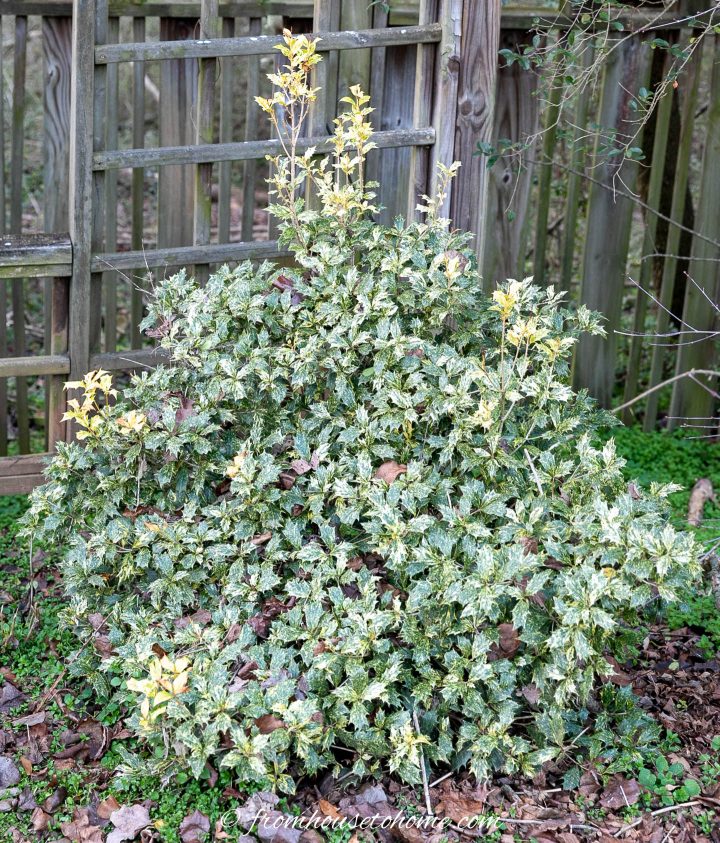
Zones: 6 to 9
Light: Sun to Part Shade
Bloom Time: Foliage Only
Height: 15′ to 20′
Spread: 8′ to 12′
Variegated English Holly is an evergreen shrub with a pyramidal growth habit and pretty white (or yellow) and green leaves (depending on the variety).
It maintains the best foliage color and produces more berries if grown in full sun. But it can also be planted in part shade.
Like other hollies, you will need a male English holly nearby to act as a pollenizer in order for the bright red berries to be produced.
It is also not a deer favorite because of the points on the leaves.
English hollies are considered invasive in some parts of the country, so check with your local nursery before planting.
Other Plants You Might Like
Have comments or questions about our evergreen shrubs for full sun? Tell us in the section below.
This post was originally published on March 5, 2021 but was updated with new content on November 23, 2024.




















